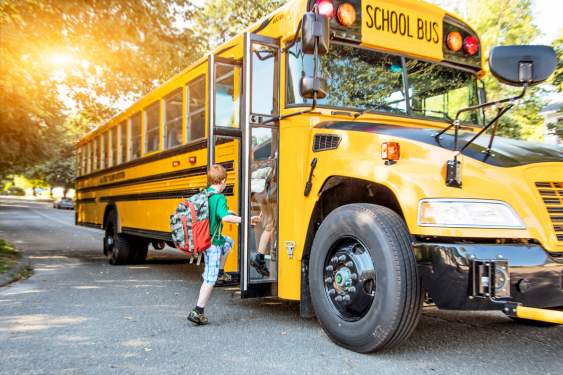
Written by Kayla Jane Barrie Updated on Aug 27, 2025 4 mins read

Did you know the stopping-for-school-buses law applies on all roads, regardless of the speed limit or location? It is extremely important to follow the rules of the road, especially regarding school buses.
School buses are not just a means of transportation for students; they are a shared responsibility of all drivers to guarantee the safety of children during their commute to and from school. Let’s look at the intricacies of school bus laws and fines that every driver should know.
One of the most fundamental laws regarding school buses requires all drivers to stop when a school bus is picking up or dropping off passengers. When a school bus extends its stop arm and flashes its lights, drivers must stop. Failing to stop in such situations can have severe consequences. Here are a few more considerations:
The law that requires drivers to stop for school buses only applies to chrome yellow school buses with proper markings and signals as defined in Section 175 of the Highway Traffic Act. This law only applies when the bus is loading or unloading adults with developmental disabilities or children.
Drivers of other school vehicles should know this law does not protect them. Therefore, they should choose safe places to stop and direct their passengers carefully as they leave the bus.
One of the most important laws regarding school buses is that all drivers must stop when a school bus is picking up or dropping off passengers. This rule applies no matter which direction you travel, with only a few exceptions based on specific road configurations and barriers.
When a school bus extends its stop arm and flashes its lights, it’s not just a suggestion - it's the law.
Failing to stop for a school bus is a serious offence. Here are the fines and penalties:
Violating school bus laws can result in severe penalties, such as hefty fines, demerit points on your license, and even suspension.
In many jurisdictions, the specific laws regarding passing a school bus without flashing lights can vary. However, it is generally legal to pass a school bus when its lights are not flashing, but only if it is safe to do so and if the bus is not actively picking up or dropping off passengers.
For example, suppose a school bus has finished loading or unloading passengers, turned off its flashing lights, and retracted its stop arm. In that case, it may be permissible to pass the bus, provided there are no children in the immediate vicinity, and it is safe to proceed according to traffic conditions.
Even if it's legal to pass a school bus without flashing lights, drivers should remain vigilant and prepared to stop if necessary, especially in school zones and areas where children may be present. Ultimately, the priority should always be the safety of children and other road users.
In 2022, Ontario introduced a new eight-light system to improve the safety of students travelling on school buses. This was in light of the Safer School Buses Act, 2021.
The new system will feature amber-yellow lights that flash as the bus approaches a stop, warning drivers that the bus will soon come to a stop. The red lights will start flashing once the bus has come to a complete stop, and the stop arm will extend. This will signal drivers in both directions to stop to allow students to get on or off the bus safely.
Here's a look at the two types of lights on a school bus:
Flashing amber lights
Flashing red lights
It is against the law to pass a stopped school bus with its red lights flashing. If a vehicle passes a stopped school bus illegally, the vehicle's owner can be charged, regardless of whether they were driving at the time.
This law applies to drivers travelling in both directions unless a median divides the road. In that case, drivers travelling in the opposite direction are not required to stop, but they should still be cautious.
The penalties for passing a stopped school bus may vary depending on the municipality. Passing a stopped school bus can also result in severe legal consequences if it leads to an accident or injury to a child. Therefore, all drivers should be aware of and comply with school bus laws to ensure the safety of everyone on the road.
When you see a school bus that has stopped and has its red lights flashing, you should stop and wait until the arm folds away and all lights stop flashing before proceeding. It is illegal and unsafe to fail to stop for a stopped school bus. You can be fined anywhere from $400 to $2,000 for a first offence and receive six demerit points.
If you have been issued a ticket for failing to stop for a school bus, it is probably because your vehicle passed a stopped school bus while children were getting on or off. In such a scenario, the bus driver notes your license plate number and reports it to the police, or someone else reports it.
To prevent school bus law violations, drivers need to know the rules in their area. Education campaigns within driving schools and public initiatives can help reinforce the importance of obeying these laws. Choosing to slow down, follow school zone signs, and obey community safety zones helps make safer roads in the province.
| Categories | Auto |
|---|---|
| Tags | Driving Tips |
Read our insurance blog to get helpful tips, information and news.
Has your car been totalled in an accident? Is your car a write off? Learn about vehicle write offs for a total loss insurance claim.
Get the facts on Toronto's auto theft problem. We break down the data, reveal the most-stolen vehicles (including the Honda CR-V and Lexus RX 350), and show which neighbourhoods are most affected.
Dive into the world of auto theft with our blog on the most stolen cars in Canada. See the most stolen cars across Canada, including provincial lists for Ontario and Quebec, and learn how high-risk models can affect your car insurance premiums.
Drive safe this winter! Check out these tips for driving in snowy and icy conditions in Ontario. Get other helpful info and FAQs on winter driving.